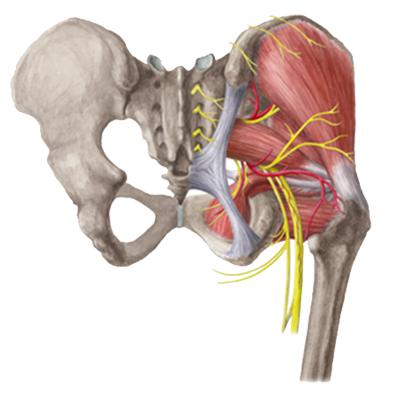Pelvic Pain
Pelvic pain is pain located anywhere between the the level of the belly button (umbilicus) and above the knees. Often pelvic pain patients present with a dysfunction relating to their musculoskeletal system making physical therapy a viable treatment option.
Symptoms of pelvic pain include:
- Abdominal pain
- Bladder pain, urinary urgency/frequency
- tailbone pain, rectal pain
- pain from previous surgical scarring
- pain with bowel movements, constipation
- in females painful intercourse, pain in vulva
- in males pain in genitals, pain following prostate surgery, sexual dysfunction
- Pudendal Neuralgia/Neuropathy
Pudendal Neuralgia/Neuropathy
 The pudendal nerve is one of the significant nerves in the pelvis region which can be associated with chronic pelvic pain or genital pain. The pudendal nerve innervates the rectum, anus, urethra, perineum, genital area, and pelvic floor muscles. When irritated, this nerve causes hypertonus or tightening of the muscles it innervates such as the pelvic floor levator ani muscles. There can be a severe, throbbing, or stabbing pain felt along the distribution of this nerve. Typically there are three branches of the nerve on each side of the pelvis: the rectal branch, the perineal branch, and the dorsal clitoral/penile branch. An injury or abnormality of this nerve can cause the painful condition of pudendal neuralgia.
The pudendal nerve is one of the significant nerves in the pelvis region which can be associated with chronic pelvic pain or genital pain. The pudendal nerve innervates the rectum, anus, urethra, perineum, genital area, and pelvic floor muscles. When irritated, this nerve causes hypertonus or tightening of the muscles it innervates such as the pelvic floor levator ani muscles. There can be a severe, throbbing, or stabbing pain felt along the distribution of this nerve. Typically there are three branches of the nerve on each side of the pelvis: the rectal branch, the perineal branch, and the dorsal clitoral/penile branch. An injury or abnormality of this nerve can cause the painful condition of pudendal neuralgia.
Common symptoms of Pudendal Neuralgia:
Burning, tingling, numbness, stabbing, aching pain, or a feeling of a lump in vagina or rectum, abnormal temperature sensations, or hypersensitivity to touch or pressure.Painful bowel movements, muscle spasms, constipation, burning
Urinary dysfunction: frequency or urgency, feeling a need to urinate when bladder is empty, urethral burning, urinary retention.
Sexual dysfunction : pain during or after intercourse
Intolerance to tight pants or elastic bands around legs
Pain that is worse with sitting, or is constant in all positions, it may be decreased with sitting on a toilet.
Physical therapy treatment for pelvic pain includes an assessment and treatment of posture, pelvic alignment, joint mobility (such as sacroiliac joints, pubic symphysis, tailbone, hips, thoracic/lumbar spine). Soft tissue assessment includes muscles, myofascial and connective tissue related to these joints including muscles of the pelvic floor, abdominals, hips and spine. Manual therapy techniques are utilized to decrease muscle tension or myofascial trigger points, biofeedback is utilized for pelvic floor muscles to help increase awareness of tension in these muscles and how to relax as well as contract them and progress with strengthening of these muscles when appropriate.
